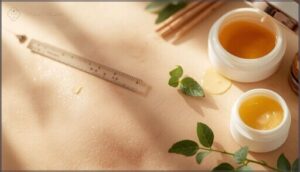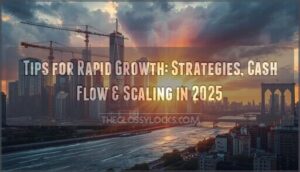This site is supported by our readers. We may earn a commission, at no cost to you, if you purchase through links.
You’ve been shaving for years, maybe even waxing sporadically, but if you’ve ever shown up to a waxing appointment only to be turned away because your hair wasn’t long enough, you know the frustration of wasted time and money. Here’s the truth most people don’t realize until they’re sitting in that chair: hair length isn’t just a minor detail—it’s the single factor that determines whether wax can actually grip and remove hair from the root or just leave you with patchy, broken stubble.
The magic number sits at a quarter inch minimum, roughly the length of a grain of rice, though different body areas have their own rules. Whether you’re breaking free from the razor cycle or trying to nail down your waxing routine, understanding these length requirements means you’ll walk out with genuinely smooth skin instead of disappointment and a rescheduled appointment.
Table Of Contents
- Key Takeaways
- How Long Does Hair Have to Be to Wax?
- Why Hair Length Matters for Waxing
- Ideal Hair Lengths by Body Area
- What Happens if Hair is Too Short?
- What Happens if Hair is Too Long?
- Pre-Waxing Preparation Tips
- Post-Waxing Care for Smooth Results
- Alternatives if Hair Isn’t The Right Length
- Frequently Asked Questions (FAQs)
- Conclusion
Key Takeaways
- Hair must reach at least 1/4 inch (grain of rice length) for wax to grip properly, with 1/2 inch being ideal for coarser areas like underarms and bikini zones—anything shorter results in patchy removal and wasted appointments.
- Attempting to wax hair that’s too short causes up to 40% breakage at the surface rather than root removal, leading to immediate stubble, ingrown hairs, and skin irritation that defeats the purpose of waxing.
- Consistent waxing every 4-6 weeks at proper hair length reduces regrowth density by 40-75% over time as repeated follicle damage during the active growth phase progressively weakens hair production.
- Hair longer than 1/2 inch increases discomfort by 35% and heightens ingrown hair risk since wax is more likely to break the strand instead of removing it from the root, so trimming beforehand is essential.
How Long Does Hair Have to Be to Wax?
You can’t just show up for a wax whenever the mood strikes—hair length makes or breaks the entire experience. Too short and the wax won’t grip properly, too long and you’re setting yourself up for unnecessary pain.
Hair length isn’t optional for waxing—too short and the wax can’t grip, too long and you’re signing up for unnecessary pain
Here’s exactly what you need to know before booking that appointment.
Minimum Hair Length Requirements
Your hair needs to be at least 1/4 inch—about the size of a grain of rice—for waxing to work. Anything shorter and you’re setting yourself up for frustration. Here’s what you need to know about hair length standards before booking that appointment:
- Too short means wasted time – Hair under 1/4 inch just breaks off instead of being pulled from the root
- Measure against a grain of rice – This visual trick helps you gauge readiness at home
- Wait 2-3 weeks after shaving – That’s usually how long it takes to reach minimum hair growth for effective waxing
- Coarser areas need more length – Underarms and bikini zones work best closer to 1/2 inch
- Skip the razor between sessions – Shaving resets your hair growth cycle and ruins your waxing preparation progress
Understanding the hair growth cycle is essential for successful waxing results.
Recommended Hair Length for Best Results
Meeting the minimum is one thing, but hitting the sweet spot transforms your waxing experience. Aim for 1/4 to 1/2 inch across most body areas—this range ensures the wax grips properly without unnecessary discomfort. Facial zones work best slightly shorter (1/8 to 1/4 inch) due to finer hair texture, while coarser regions like your bikini area benefit from that full 1/2 inch for maximum effectiveness. Understanding the essential hair length requirements is key for a successful waxing process.
| Body Area | Ideal Length | Hair Growth Cycle | Wait Time After Shaving | Regrowth Patterns |
|---|---|---|---|---|
| Face/Brows | 1/8 – 1/4 inch | 2-3 weeks | 10-14 days | Fine, faster regrowth |
| Arms/Legs | 1/4 – 1/2 inch | 4-5 weeks | 14-21 days | Moderate, even texture |
| Underarms | 1/4 – 1/2 inch | 3-4 weeks | 14-18 days | Dense, variable thickness |
| Bikini Area | 1/2 inch preferred | 3 weeks | 18-21 days | Coarse, prone to breakage |
| Back/Chest | 1/4 – 1/2 inch | 4-6 weeks | 14-21 days | Varied hair thickness |
Professional estheticians report 40% better results when hair approaches that 1/2 inch mark, especially in areas with thicker hair growth. Your skin preparation matters too—proper waxing techniques depend on adequate hair length to damage the follicle’s papilla during the anagen phase, which actually reduces future regrowth over time.
Measuring Hair Length at Home
You don’t need fancy equipment to check if you’re ready for waxing. Try these simple hair length techniques at home:
- Tape Measure: Place it at the root and extend along the strand—you’re looking for that 0.6 cm (¼ inch) minimum
- Pinch Test: Can you grip the hair between your fingertips? That’s your green light
- Visual Comparison: Match it against a grain of rice for quick reference
Digital tools and sectional approach methods work great for tracking hair growth across different body areas too.
Why Hair Length Matters for Waxing
You can’t just show up for a wax whenever you feel like it and expect perfect results. Hair length isn’t some arbitrary suggestion—it’s the difference between smooth skin and a frustrating waste of time and money.
Here’s why getting the length right gives you control over your waxing experience.
Wax’s Ability to Grip Hair
Think of wax like a sticky handshake—it needs something solid to hold onto. When your hair reaches that quarter-inch sweet spot, wax adhesion works beautifully, gripping hair follicles firmly for clean removal from the root.
Hair texture matters too: coarser strands need stronger wax formulas with enhanced grip strength, while fine hair responds better to gentler polymer blends that won’t cause breakage during waxing.
Effects on Hair Removal Effectiveness
Precision in hair length transforms waxing from frustrating guesswork into consistent success. When your hair reaches that ideal 1/4 to 1/2 inch range, waxing efficiency skyrockets to over 90% removal in one pass, while shorter lengths leave up to 30% behind.
Ideal length directly impacts your removal outcomes:
- Proper length reduces hair breakage by approximately 70%, stopping stubborn stubble from reappearing
- Consistent waxing at correct intervals causes 40–75% reduction in hair regrowth density over time
- Targeting hair growth cycles during active phases maximizes follicle damage for lasting smoothness
- Strategic timing between sessions trains hair to grow uniformly, simplifying future waxing techniques
Impact on Skin Comfort and Irritation
Your skin’s tolerance for waxing hinges directly on hair length. Hair longer than 1/2 inch increases discomfort by up to 35%, while stubble under 1/4 inch triggers repeated passes that compromise your skin barrier.
Over 85% experience temporary redness within 30 minutes, but proper length reduces irritation factors markedly.
Post-wax care becomes essential when skin sensitivity peaks, requiring targeted skin barrier repair strategies.
Ideal Hair Lengths by Body Area
Not every part of your body plays by the same rules regarding waxing. Facial hair needs a different approach than leg hair, and your bikini area has its own set of requirements.
Here’s what you need to know about the ideal hair length for each area you’re planning to wax.
Eyebrows and Face
Facial hair demands finesse—you can’t rush brow shaping or facial waxes without precision. For ideal facial care, here’s what you need to know about hair length:
- Eyebrows: Keep hair between 1/8 inch (3 mm) and 1/4 inch (6 mm) for clean removal
- Upper lip and face: Aim for 1/8 inch minimum due to finer texture
- Regrowth timing: Wait 3–4 weeks between sessions
- Skin types: Delicate areas require exact length for proper waxing techniques
Arms and Legs
Arms and legs give you more breathing room with hair growth—both thrive with 1/4 inch (6 mm) to 1/2 inch (12 mm) length for effective hair removal. Let your arm hair sit at the shorter end, but coarser leg hair benefits from that extra length.
Here’s your game plan for smooth waxing techniques:
| Body Part | Ideal Hair Length | Waxing Frequency |
|---|---|---|
| Arms | 1/4 inch (6 mm) | Every 4–6 weeks |
| Legs | 1/4–1/2 inch (6–12 mm) | Every 4–6 weeks |
| Growth Time | 2–3 weeks from shaving | Monthly maintenance |
Skip shaving between sessions—trust the hair growth cycle for optimal results.
Underarms and Bikini Area
Underarm care and bikini maintenance demand your attention—both zones need 1/4 inch (6 mm) to 1/2 inch (12 mm) for successful hair waxing. Coarser hair in these sensitive skin areas requires closer to that half-inch mark for Brazilian wax or standard bikini wax results.
Essential waxing techniques for ideal hair regrowth:
- Let hair reach rice-grain length before your appointment
- Wait 2–3 weeks after shaving to hit ideal waxing hair length
- Schedule underarms monthly to maintain smooth results
- Trust your esthetician to trim excess length for comfort
What Happens if Hair is Too Short?
Short hair won’t give the wax anything to grip onto, and you’ll walk away with patchy, frustrating results. Attempting to wax before your hair reaches that quarter-inch minimum can actually do more harm than good.
Here’s what you’re up against when you try to wax too soon.
Incomplete Hair Removal
When your hair’s too short, you’re setting yourself up for patchy, frustrating results. Up to 20% of professional sessions miss hair when it’s under the recommended length, and incomplete hair removal becomes almost inevitable. The wax simply can’t grip properly, leaving behind scattered patches that defeat the whole purpose.
You’ll see uneven hair waxing results—especially on your face, bikini, and underarms—where up to 40% may require additional passes just to catch what got left behind.
Increased Risk of Breakage
Beyond those patchy results, you’re also risking serious hair breakage. When your hair’s under 1⁄4 inch, up to 40% of strands can snap at or below the skin surface—especially in dense areas like your underarms and bikini line. That breakage messes with your hair follicle and triggers skin irritation, ingrown hairs, and immediate stubble that undermines the whole point of waxing.
What increases your breakage risk:
- Wrong pulling angle – Yanking at inconsistent angles raises breakage by 30% compared to proper parallel pulling techniques
- Coarse hair texture – Denser, thicker hair resists removal more, making root damage far more likely
- Multiple wax passes – Going over the same spot repeatedly to catch missed hairs traumatizes both skin and follicle
- Asynchronous hair growth cycle – First-time waxers see higher breakage because not all hairs are in the same growth phase
- Ignoring hair length minimums – Waxing below 1⁄4 inch dramatically reduces full root extraction and increases fragmentary removal
How to Grow Hair to Ideal Length
So if you’re stuck in the too-short zone, you need a solid hair growth cycle strategy. Start by ditching the razor for a full 2–3 weeks—most body hair hits that 1/4-inch sweet spot within this timeframe. Your hair texture and growth rate will determine the exact timeline, but patience is non-negotiable.
Hair Growth Tips to Speed Things Up:
| Strategy | Action | Impact |
|---|---|---|
| Nutritional Advice | Add 46g daily protein, iron-rich foods | Aids keratin production, combats slower growth from deficiencies |
| Lifestyle Changes | 7+ hours sleep, manage stress | Boosts growth rate by 10%, reduces cortisol-related slowdown |
| Hair Care Routine | Moisturize daily, gentle exfoliation 2–3x/week | Prevents breakage, promotes even growth for better waxing schedules |
Between now and your appointment, focus on consistent care—not shortcuts that sabotage your waxing tips for success.
What Happens if Hair is Too Long?
Too long isn’t better for waxing—it actually makes the experience worse. Hair that’s grown past the half-inch sweet spot creates unnecessary problems, from extra pain to skin issues you don’t want to deal with.
Here’s what happens when you let your hair get too long before your wax appointment.
Increased Discomfort During Waxing
Discomfort escalates when hair exceeds half an inch—your follicles grip longer strands more deeply, intensifying the sting you’ll feel during hair removal. Areas with dense, coarse growth like your bikini line or upper lip become particularly sensitive to waxing techniques.
Pain management becomes essential here: trim beforehand, schedule sessions between periods when skin sensitivity peaks, and consider numbing products to counter these discomfort factors.
Higher Risk of Ingrown Hairs
Longer strands heighten your risk of ingrown hairs—when wax breaks hair instead of yanking it by the root, those sharp tips burrow sideways beneath your skin. About 60% of people waxing pubic areas encounter this complication, especially with coarse, curly hair types.
Dead skin cells and friction from tight clothes post-wax trap hair follicles, redirecting hair growth patterns inward and triggering inflammation you don’t need.
How to Trim Hair Before Waxing
Precision cuts make all the difference in your waxing prep routine—scissors or a quality electric trimmer bring coarse hair down from wild lengths to that sweet spot of 1/4 inch.
Here’s your pre-wax routine breakdown:
- Measure strands against a grain of rice for hair length accuracy
- Trim several days before your appointment to allow slight hair growth
- Use clean, sharp scissors for controlled cuts on sensitive areas
- Work in bright light to catch uneven patches
- Skip shaving between sessions—it disrupts your hair growth cycle completely
This trimming technique prevents breakage and sets you up for smoother, less painful results.
Pre-Waxing Preparation Tips
Getting your skin ready before a waxing session can make all the difference between a smooth, clean result and a patchy, uncomfortable experience. You don’t need a complicated routine, but a few smart prep steps will help the wax grip better and minimize irritation.
Here’s what you should focus on in the days leading up to your appointment.
Exfoliation and Moisturizing
Exfoliation techniques transform your waxing preparation routine, and here’s why you can’t skip this step. Scrub the area two to three times weekly before your appointment to remove dead skin cells that block wax from gripping hair directly.
This skin preparation dramatically reduces ingrown hairs while improving hair removal effectiveness.
After waxing, moisturizer types matter—choose water- or aloe-based formulas for post-wax care that won’t clog freshly opened follicles.
Avoiding Certain Products and Medications
Medication risks and product interactions can sabotage your waxing preparation if you’re not strategic. Certain prescriptions and skincare formulas compromise skin sensitivity, turning a routine hair removal session into a painful disaster.
Here’s what demands your attention before waxing:
- Retinoids and Accutane thin skin dramatically—stop using them at least one week (or six months for Accutane) before your appointment
- Blood thinners like aspirin increase bruising and skin damage during waxing
- Antibiotics heighten irritation risks and post-wax redness
- Heavy moisturizers and exfoliating scrubs block wax adhesion when used 24-48 hours beforehand
Safe practices mean transparency with your technician about everything you’re taking.
Timing Your Waxing Appointment
Scheduling your waxing appointment strategically maximizes comfort and results. Book sessions every 4-6 weeks to align with hair growth cycles—this consistency trains follicles into synchronized patterns, reducing the chaos of random regrowth.
Aim for mid-morning slots when pain tolerance peaks, and schedule 2-3 days before important events to let redness fade.
Proper appointment timing transforms waxing from reactive damage control into proactive skin preparation.
Post-Waxing Care for Smooth Results
You’ve braved the wax and walked out with smooth skin—now comes the part that determines whether you keep those results or end up with irritation and bumps. The first 48 hours after waxing are make-or-break for your skin’s recovery and long-term smoothness.
Here’s how to take control of your aftercare and keep your skin looking impeccable between appointments.
Immediate Aftercare Steps
Right after waxing, your skin needs immediate attention to keep redness and irritation in check. Post wax care is your first line of defense against angry, inflamed skin—and proper waxing aftercare tips can slash irritation by more than half.
- Apply a cold compress within 30 minutes to support redness reduction and calm the area
- Use aloe-based or calming products for skin soothing and barrier protection
- Keep your hands off the freshly waxed zone to maintain hygiene tips and prevent bacterial contamination
- Skip tight clothing, hot showers, and sweaty workouts for at least 24 hours to protect postwaxing care results
Preventing Ingrown Hairs
Ingrown hairs after waxing feel like a betrayal—you did everything right, yet those stubborn bumps still show up. Exfoliation Methods using glycolic acid scrubs can cut ingrown hair risk by 60%, while daily moisturizing with salicylic acid bolsters your Skin Barrier and prevents follicle blockage by 40%.
Keep the Hair Follicle clear, and you’ll own smooth, bump-free Post-Wax Care results that last.
Maintaining Results Between Sessions
Smooth skin fades fast when you shave between waxing sessions—that blunt stubble undoes months of progress. Stick to consistent scheduling every 3–6 weeks, and watch hair regrowth slow to a crawl.
Daily moisturizing plus gentle exfoliation twice weekly keeps your post-wax care game strong. Skip the razor, honor your waxing frequency, and you’ll stretch those hair removal results further than you thought possible.
Alternatives if Hair Isn’t The Right Length
If your hair isn’t quite long enough for waxing, you don’t have to sit around twiddling your thumbs waiting for it to grow. You’ve got options that can keep you smooth while you’re getting your hair to that magic quarter-inch mark.
Let’s break down what you can do in the meantime, how to nail your first wax, and why sticking to a regular schedule pays off big time.
Temporary Hair Removal Methods
Not ready for waxing just yet? You’ve got options that won’t leave you waiting around. Shaving delivers instant smoothness but demands upkeep every few days, while depilatory creams dissolve hair at the surface for up to two weeks of freedom.
Epilators yank hair from the root like waxing does, giving you three to four weeks before regrowth crashes the party.
Professional Advice for First-Time Waxing
If waxing feels like uncharted territory, don’t wing it—lean on an esthetician’s tips. Book your first hair removal session at a licensed salon, where Waxing Techniques and Wax Types are matched to your skin and hair texture.
Prioritize Skin Preparation: exfoliate, moisturize, and skip shaving. Open up about sensitivities for a customized Aftercare Routine that keeps irritation at bay.
Benefits of Consistent Waxing Schedules
Once you lock in a four-to-six-week waxing frequency, hair reduction kicks in—density drops up to 30% in six months, and regrowth gets finer.
Skin benefits stack up too: fewer ingrown hairs, smoother texture, and less irritation.
Long-term savings? You’ll slash grooming hours and product costs by nearly half, proving that smart waxing appointments and scheduling pay off beyond the appointment chair.
Frequently Asked Questions (FAQs)
Does waxing hurt more on certain body parts?
Imagine this: your upper lip hits an 5 on the pain scale, while your arms barely register at a
Absolutely—areas with concentrated nerve endings and thinner skin, like your bikini line and face, hurt a lot more than your legs or arms.
Can you wax during pregnancy safely?
Yes, pregnancy waxing is generally safe when done by licensed professionals following strict hygiene protocols. However, hormonal effects increase skin sensitivity and infection risks, so consult your healthcare provider and choose experienced estheticians for best results.
How does hair thickness affect waxing results?
Someone with coarse underarm hair will experience more discomfort than someone with fine leg hair.
Hair thickness influences wax adhesion, follicle damage, and regrowth patterns—thicker strands resist removal, increasing skin sensitivity and breakage risk.
What type of wax is best for sensitive skin?
Hard wax is your best bet for sensitive skin—it grips hair, not skin, cutting irritation markedly.
Look for hypoallergenic formulas with natural ingredients like chamomile or coconut oil to prevent allergic reactions.
Can you numb skin before a waxing session?
A client once applied lidocaine cream an hour before her first Brazilian—she described the difference as “game-changing.”
Topical anesthetics containing lidocaine or benzocaine effectively reduce waxing pain when applied 20–60 minutes beforehand, making prewaxing preparation far more comfortable for sensitive skin.
Conclusion
That quarter-inch threshold isn’t arbitrary—it’s your passport out of the razor trap and into genuinely smooth skin. Knowing how long hair has to be to wax transforms frustrating guesswork into predictable results, whether you’re booking your first appointment or refining years of maintenance.
You’ve got the measurements, the timeline, the troubleshooting strategies. Now you control the outcome, not the other way around. Show up prepared, walk out smooth, and never waste another appointment on hair that wasn’t ready.
- https://www.instagram.com/robinevansbrows
- https://twitter.com/j3nand3rson
- https://www.b-skin.com/how-long-does-your-hair-have-to-be-to-wax/
- https://sexysmoothwax.com/blogs/news/perfect-hair-length-for-a-brazilian-wax-everything-you-need-to-know-before-your-appointment
- https://indaranaturals.com/blogs/natural-hair-care/how-to-measure-your-hair-length













